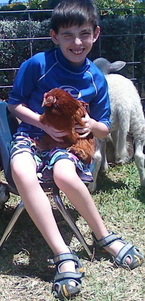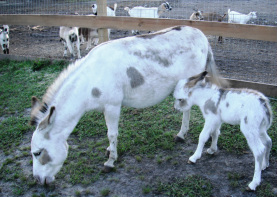Meet Our Petting Pals
|
Nigerian Dwarf Goats and Pygmy Goats
The Nigerian Dwarf goat is a miniature dairy goat breed of West African ancestry. The original animals were transported from Africa on ships as food for captured carnivores being brought to zoos; the survivors were then maintained in herds at those zoos. Nigerian Dwarf goats are popular as pets and family milkers due to their easy maintenance and small stature. However, because of their high butterfat, they are also used by some dairies to make cheese. The Pygmy goat is a breed of miniature domestic goat. Pygmy goats tend to be kept as pets primarily, though also work well as milk producers and working animals. The pygmy goat is quite hardy, an asset in a wide variety of settings, and can adapt to virtually all climates. Castrated males are called wethers and can be shown in pet classes. Llamas The llama is a domesticated South American camelid, widely used as a meat and pack animal by Andean cultures since the Pre-Columbian era. They are very social animals and live with other llamas as a herd. The wool produced by a llama is very soft and lanolin-free. Llamas are intelligent and can learn simple tasks after a few repetitions. Domino Domino is HAPPI Farm's oldest goat. He'll climb on anything to reach and eat a Palm Tree. With his long horns and blue eyes, he is quite a sight to see! You can see many different types of goats at HAPPI Farm! Emus Emus are soft-feathered, brown, flightless birds with long necks and legs, and can reach up to 1.9 metres (6.2 ft) in height. Emus can travel great distances, and when necessary can sprint at 50 km/h (31 mph); they forage for a variety of plants and insects, but have been known to go for weeks without eating. They drink infrequently, but take in copious amounts of water when the opportunity arises. Rabbits Rabbits are small mammals in the family Leporidae of the order Lagomorpha, found in several parts of the world. There are eight different genera in the family classified as rabbits, including the European rabbit , cottontail rabbits, and the Amami rabbit an endangered species on Amami Ōshima, Japan. There are many other species of rabbit, and these, along with pikas and hares, make up the order Lagomorpha. The male is called a buck and the female is a doe; a young rabbit is a kitten or kit. Sheep The sheep is a quadrupedal, ruminant mammal typically kept as livestock. Like all ruminants, sheep are members of the order Artiodactyla, the even-toed ungulates. Numbering a little over one billion, domestic sheep are also the most numerous species of sheep. An adult female sheep is referred to as a ewe, an intact male as a ram or occasionally a tup, a castrated male as a wether, and a younger sheep as a lamb. Pigs A pig is any of the animals in the genus Sus, within the Suidae family of even-toed ungulates. Pigs include the domestic pig and its ancestor, the common Eurasian wild boar, along with other species; related creatures outside the genus include the peccary, the babirusa, and the warthog. Pigs, like all suids, are native to the Eurasian and African continents. Juvenile pigs are known as piglets. Pigs are highly social and intelligent animals. Call Ducks The Call Duck is a bantam breed of domesticated duck raised primarily for decoration or as pets. Call ducks look similar to some other duck breeds, but are smaller in size. Call ducks were initially used in hunting, where their own calls and quacks would attract wild ducks towards the hunter's guns. This practice has almost entirely been replaced with artificial Duck calls, with Call ducks now being kept primarily as pets or for ornamental purposes. Tortoises Tortoises are a family, Testudinidae, of land-dwelling reptiles in the order Testudines. Tortoises are shielded from predators by a shell. The top part of the shell is the carapace, the underside is the plastron, and the two are connected by the bridge. The carapace is fused to both the vertebrae and ribcage, and tortoises are unique among vertebrates in that the pectoral and pelvic girdles are inside, rather than outside, the ribcage. Tortoises can vary in size from a few centimeters to two meters. They are usually diurnal animals with tendencies to be crepuscular depending on the ambient temperatures. They are generally reclusive animals. Cochin Chickens The Cochin or Cochin China, is a breed of chicken. The name Cochin came from the original Chinese name 九斤黄(in pinyin: jiujin huang), meaning nine-catty yellow, erroneously conflated with the then-current names for what are now parts of southern India and Vietnam, where jin is a traditional Chinese measurement of weight. In China itself, the name 九斤黄 is actually used for any large chicken or even a dish made from one. Red Foxes The red fox is the largest of the true foxes and the most abundant wild member of the Carnivora, being present across the entire Northern Hemisphere from the Arctic Circle to North Africa, North America and Eurasia. Its range has increased alongside human expansion, having been introduced to Australia, where it is considered harmful to native mammals and bird populations. Due to its presence in Australia, it is included among the list of the "world's 100 worst invasive species". Miniature Donkeys Miniature donkeys are 36 inches or less at the withers when fully grown, and are usually measured in inches. In the 20th century, donkeys came to be more frequently kept as pets in the United States and in other wealthy nations. In 1929 Robert Green of New York imported seven donkeys of the small indigenous Sardinian breed to the United States. The first foal was born in the same year. Although never considered miniature in their country of origin, these animals were soon known as Miniature Donkeys. Miniature Zebu Cows and Bulls The Miniature Zebu Cow is found in Africa and it is known for the hump extending from the neck to the back. Zebus grow no more than 42 inches tall and live to be about 18 years old. They are quite rare and are more intelligent than the other breeds. A bull is an intact adult male of the species Bos taurus (cattle). More muscular and aggressive than the female of the species, the cow, the bull has long been an important symbol in many cultures, and plays a significant role in both beef and dairy farming, and in a variety of other cultural activities. Turkeys
The turkey is a large bird in the genus Meleagris, which is native to the Americas. One species, Meleagris gallopavo (commonly known as the domestic turkey or wild turkey), is native to the forests of North America, mainly Mexico and the United States. The other living species is Meleagris ocellata or the ocellated turkey, native to the forests of the Yucatán Peninsula. Males of both turkey species have a distinctive fleshy wattle or protuberance that hangs from the top of the beak (called a snood). They are among the largest birds in their ranges. As in many galliformes, the male is larger and much more colorful than the female. |
















